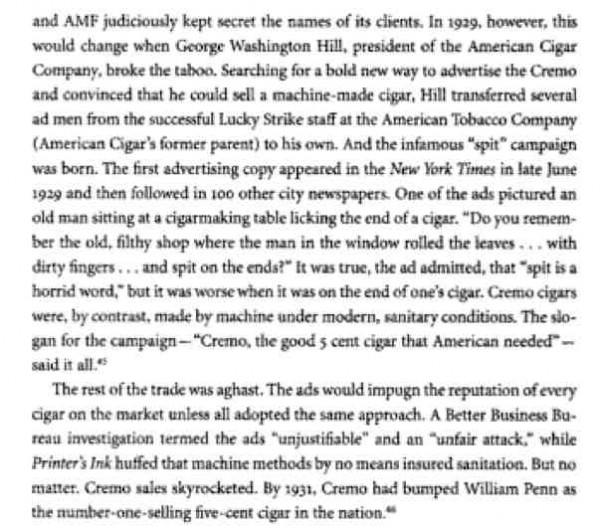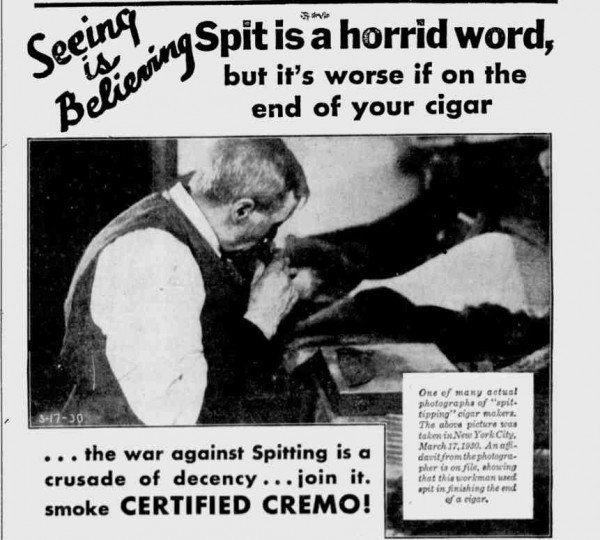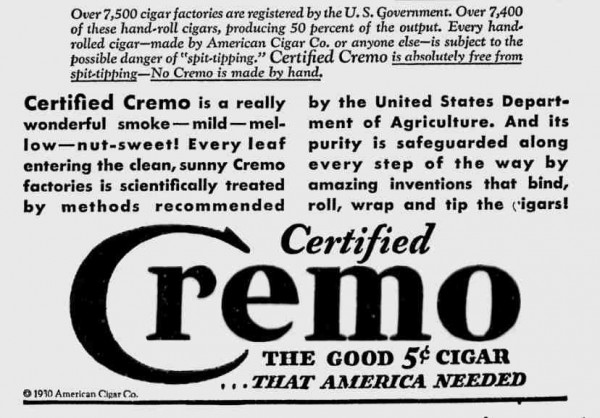Cremo and Spit-tipped Cigars
We all know that ad campaigns have often created the disease or deficiency they wish to sell remedies for. "Halitosis" and "BO" were Madison Avenue inventions.
But perhaps no campaign dared quite as much as that for Cremo cigars, with its charge that all its competitors spit on their product.

Original text here.


Original ad here. (Scroll down.)
But although Cremo increased its market share, their scheme ultimately backfired.
As this history says:
But perhaps no campaign dared quite as much as that for Cremo cigars, with its charge that all its competitors spit on their product.

Original text here.


Original ad here. (Scroll down.)
But although Cremo increased its market share, their scheme ultimately backfired.
As this history says:
During the 1920s, the cigar industry began to suffer from image problems. The rise of organized crime during Prohibition, and the image of the stogie-chomping gangster--developed in part by Hollywood, and personified by such actors as Edward G. Robinson--gave the cigar an aura of disrespect among the public. Later that decade, the cigar industry faced a second crisis, when American Tobacco began promoting new, machine-rolled cigars. Its advertising asked: "Why run the risk of cigars made by dirty yellowed fingers and tipped in spit?" The image proved disastrous for the cigar industry as a whole. Cigar makers rushed to convert their manufacturing from hand-rolled to machine-rolled products, but cigar sales plunged through the 1930s. During this same time period, the cigar industry was hit hard by the rise in cigarette use across the United States. Cigar consumption never recovered to its early 1920s peak.
Comments
Won the battle but lost the war.
Posted by Patty in Ohio, USA on 04/18/12 at 09:26 AM
Spit on the end of a cigar? That's why you have a ring cutter to trim the end. The heat of burning will kill any little beasties left behind on the wrapper.
I just wish that one could still find a good cigar for 5 cents. Finished tobacco products are so high in price because of all the taxes the do-gooders have tacked on here in the States. I checked the price of a box of Havana made cigars while on my way out of Paris last month and the price was about the same as I paid some twenty five years ago.
I just wish that one could still find a good cigar for 5 cents. Finished tobacco products are so high in price because of all the taxes the do-gooders have tacked on here in the States. I checked the price of a box of Havana made cigars while on my way out of Paris last month and the price was about the same as I paid some twenty five years ago.
Posted by KDP on 04/18/12 at 10:02 AM
I remember Wm. Penns but never heard of Cremos and I started on cigars back in the early 60's.
@KDP: I'm going to discount the "do gooders" on this one as, IMHO, they were/are only used as an excuse by Big Brother to gather in tax money.
@KDP: I'm going to discount the "do gooders" on this one as, IMHO, they were/are only used as an excuse by Big Brother to gather in tax money.
Posted by Expat47 in Athens, Greece on 04/18/12 at 11:45 AM
Great find!
It's pretty rich when tobacco purveyors start pointing at the risks of spit on competitors' products. Then you remember that the product kills half of all consumers when used as recommended.
It's pretty rich when tobacco purveyors start pointing at the risks of spit on competitors' products. Then you remember that the product kills half of all consumers when used as recommended.
Posted by Harvey on 04/18/12 at 09:14 PM
@Harvey - agree! Sucking on a tube of what looks and smells like burning dog feces that will create cancerous plaques in your mouth and you are worried about a little dried spit on the end of it??!! And never mind that the smoke they blow out is full of still-moist microscopic saliva particles full of the germs they were so afraid of in the first place. I have no problems with people smoking ---- as long as when I drink I can blow my beverage out on them standing next to me the way they blow their smoke on me. Or if I can spray air freshener on them to match the stink of the smoke. They don't seem to like that though. Hmmmm....
Posted by ScoutC on 04/20/12 at 06:20 PM
Commenting is not available in this channel entry.

Category: Business | Advertising | Products | Lies, Dishonesty and Cheating | Smoking and Tobacco | 1920s | 1930s